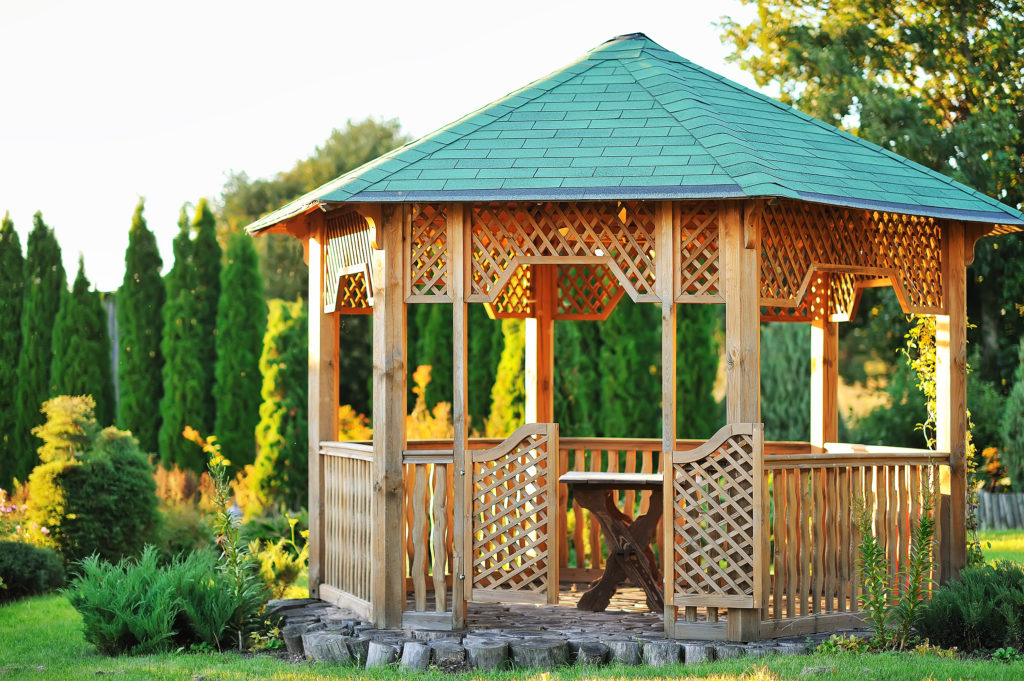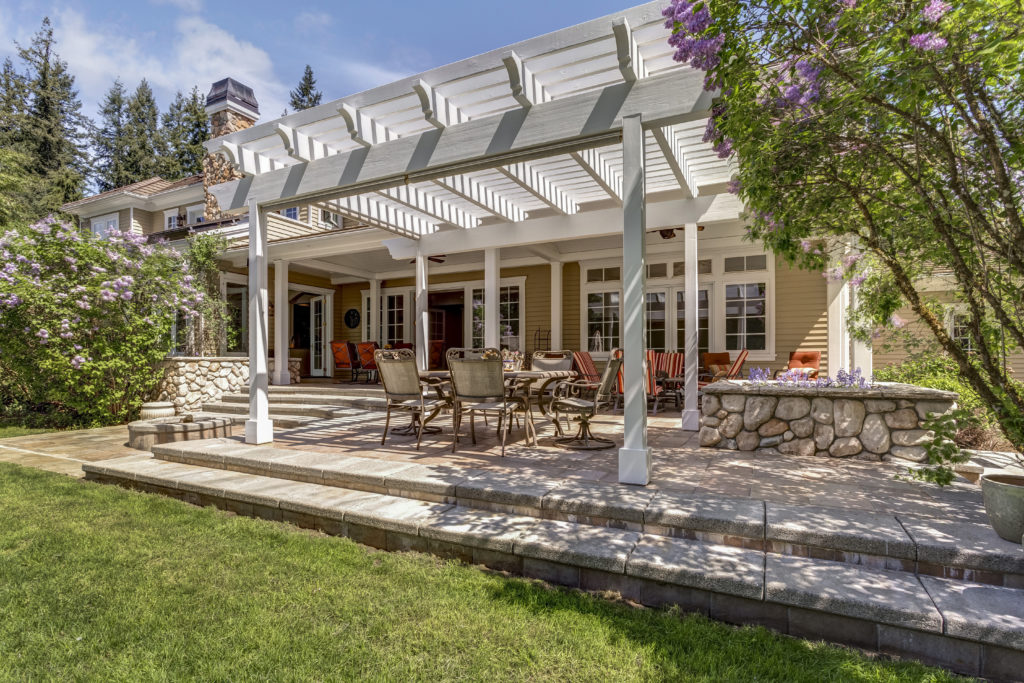When choosing to revamp your yard, you might wonder what the main differences are between a pergola vs a gazebo. They both add value to your home and can make your backyard look beautiful- but how do you choose? That’s where we come in- let’s get you started with all the facts.
Pergola Vs Gazebo
While gazebos and pergolas both serve to provide aesthetics and shade to your yard, the main difference between a pergola vs gazebo is the floor and roof. A gazebo has a full roof, meaning it offers more shade and protection from the sun and outside elements. Pergolas have slatted roofs which allow the sun (and all the outside elements) to come through the roof. While there are a variety of types of both gazebos and pergolas, the floor of the structure is also typically different. Typically (not always) gazebos use the same material as the roof for the floor- so a wooden gazebo will be connected to a wooden floor. Pergolas can be built anywhere and be freestanding-however we recommend its rooted in cement. Here are 23 modern pergola ideas.

Types of Gazebos
Patio
These are the most popular type of gazebo and the most permanent. They can be made from metal, wood, or vinyl- however wood is the most common and traditional. Patio gazebos are a great option for people who do not have a patio or deck already and looking for some entertainment space, or people with huge backyards who want to fill up some space.
Pop-Up
You may have one of these already and not even know it. These are the big tents you put up for a tailgate party, summer barbeque, or sports game. They are very temporary and require set up and take down. If you don’t take it down, the elements could easily destroy it. They are also really easy to find (they sell them in most home improvement stores, Walmart, and Amazon)
Grill
This is almost like a little tent for your grill. This is not intended for entertaining and are typically pretty small. These are used to put over your grill to protect it from the elements as to protect you and keep you grilling despite what the weather is like outside. Rain or shine, these grill gazebos can allow you to not cancel your dinner plans on a rainy day. Some brands even have extra shelf space for your grilling needs.

Types of Pergolas
Anchored
This is a more permanent structure from the rest. This type of pergola is rooted in the ground with cement but can also use stakes. We recommend this type of pergola over the rest so that it is protected from high winds.
Freestanding
Freestanding are exactly what they sound like- not anchored to a wall or the ground. These are a more common type for DIY-ers, but not something we exactly recommend trying at home. They can be placed onto any area of your yard or patio that is level, but are more susceptible to high winds. If you’re really unlucky these can damage your home or someone else’s. There are a lot of different kits if you want to put one together yourself and save some money.
Wall-Mounted
For these types of pergolas, one side is mounted to your home’s exterior and one side is rooted in cement over a patio or deck. The weight of one side is on the home while the other two legs are on the patio or deck. This can be a great option for people who already have a plain patio in their backyard and are looking for some way to spice it up.

Building Permits and Foundation
One thing to check with your builder are permits and underground utilities in your backyard. Some local building codes have size requirements but if the structure is less than a certain size you may not need special permission from the city. Some city codes also require that the structure is a certain distance from the road, utility poles, or your neighbor’s house.
It’s also important to know where your underground utilities are located when you’re digging a foundation for the pergola vs gazebo so that you don’t break a water, sewer, or electrical line.
More permanent structures like patio gazebos and anchor or wall mounted pergolas have concrete footers- meaning they need a foundation with good water drainage. If bolting it to your deck, use metal strapping to secure it to the beams of the deck.
Weather & Drainage
Always consider things like rain-fall drainage, location of the sun and where you will provide shade, snow and ice collection and strong winds.
Applying a sealant on your pergola or gazebo should be done after it was built and then every year after that. This will help protect the wood but is unnecessary if you have a metal or vinyl structure.

Personal Preference
The most personal difference between them is just what you like more. Some people prefer shade or the aesthetics of a gazebo while others want partial shade with a pergola. Some people think gazebos are too closed in because of the type of roof and prefer pergolas because they want a more open concept.
Some people prefer gazebos because they have more architectural design and complexity which can add some extra flavor to their backyard appeal. When you’re deciding between a pergola vs gazebo, it might help to have print out pictures to envision what it will look like in your space.
Pro’s and Con’s of Gazebos
If you’re stuck between a pergola vs gazebo, you should think about what works best for you and your family. A pro about gazebos is that it has a roof and permanent flooring. A roof with no slatting provides permanent shade and you can enjoy your gazebo even if it is raining or snowing. Having a floor also allows it to be swept and maintained easily before guests come over when you entertain. Builders can also sneak in electricity and other accessories such as built in tables and benches which make them an easy hang out spot in your yard.
On the con side, between a pergola vs gazebo, gazebos are more expensive to build because they are more difficult to build. They require more time and more materials which make them pricier than pergolas. Additionally, if you have limited yard space, these take up more than pergolas and are typically less “open” feeling. Here are some gazebo ideas if you decide that’s for you.
Let Us Help with Your Outdoor Living Project
A Deck Above is the area’s premier builder of decks and a wide variety of structures to maximize your enjoyment of outdoor living.
Pro’s and Con’s of Pergolas
One pro about pergolas is how easy they are to build. If you’re between a pergola vs gazebo and concerned about your budget, pergolas are more inexpensive due to the fact that they require less time and materials than a gazebo. Pergola’s are also more “open concept” yet allow some defined areas in your yard. Depending on your preference, partial shade can also be a pro for you. If you don’t want to completely block out the sun but have a space that is shadier for entertaining, this is a great choice for you.
However, because there is only partial shade, a pergola vs gazebo is more likely to get weathered because of the lack of protection from the elements. You can’t use your pergola on a rainy or snowy day, nor would you want to sit in it after it just rained or snowed because it would continue to be wet. You can build or get pergolas that have features that can reduce how much water can get underneath (either with a clear vinyl roof sheet, or retractable panels) but it adds to the cost and doesn’t prevent all weather from getting in.

Who’s The Winner?
In the debate of pergola vs gazebo, for me-pergolas take the cake. They are a little more cost effective and provide great outdoor living versatility. You can add on a clear tuftex top to keep direct rain from getting underneath or you can add outdoor curtains to provide some privacy from neighbors if you wanted to as well. You can typically add electricity and a ceiling fan to provide some air flow on hot days too. Pergolas also take up less visual space, so if you want it to fit more into your outdoor space without its presence taking over, it’s a great fit. Interested in building a pergola? Contact us here.


